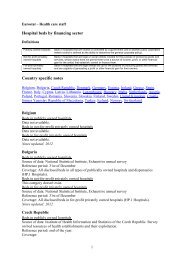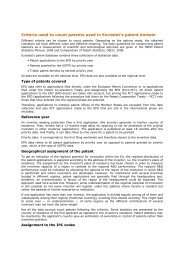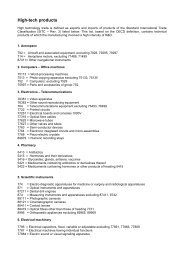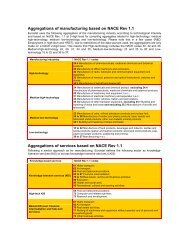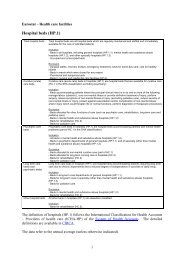Hospital discharges by diagnosis (ISHMT) - Eurostat
Hospital discharges by diagnosis (ISHMT) - Eurostat
Hospital discharges by diagnosis (ISHMT) - Eurostat
You also want an ePaper? Increase the reach of your titles
YUMPU automatically turns print PDFs into web optimized ePapers that Google loves.
<strong>Eurostat</strong> – <strong>Hospital</strong> patients<br />
<strong>Hospital</strong> <strong>discharges</strong> <strong>by</strong> <strong>diagnosis</strong> (<strong>ISHMT</strong>)<br />
<strong>Hospital</strong> <strong>discharges</strong> A (hospital) discharge is the formal release of a patient from a hospital after a procedure or course of<br />
treatment (episode of care).<br />
A discharge occurs anytime a patient leaves because of finalisation of treatment, signs out against medical<br />
advice, transfers to another health care institution or because of death. A discharge can refer to in-patients<br />
or day cases.<br />
Inclusion<br />
- Healthy newborns<br />
Exclusion<br />
- Transfers to another department within the same institution.<br />
In-patient cases An in-patient is a patient who is formally admitted (or 'hospitalised') to an institution for treatment and/or care<br />
and stays for a minimum of one night or more than 24 hours in the hospital or other institution providing inpatient<br />
care.<br />
Day cases Day care comprises medical and paramedical services (episode of care) delivered to patients that are<br />
formally admitted for <strong>diagnosis</strong>, treatment or other types of health care with the intention of discharging the<br />
patient on the same day. An episode of care for a patient who is admitted as a day-care patient and<br />
subsequently stays overnight is classified as an overnight stay or other in-patient case.<br />
<strong>Hospital</strong> days A hospital day (or bed-day or in-patient day) is a day during which a person admitted as an in-patient is<br />
confined to a bed and in which the patient stays overnight in a hospital.<br />
Inclusion<br />
- <strong>Hospital</strong> days of healthy newborns.<br />
Exclusion<br />
- Day cases (patients formally admitted for a medical procedure or surgery in the morning and released<br />
before the evening).<br />
<strong>ISHMT</strong>: International Classification for <strong>Hospital</strong> Morbidity Tabulation. This shortlist for<br />
statistical comparison of hospital activity analysis was adopted in 2005 <strong>by</strong> <strong>Eurostat</strong>, the<br />
OECD (Organisation for Economic Co-operation and Development) and the WHO-FIC<br />
(Family of International Classifications) Network.<br />
In-patient average length of stay of in-patients (ALOS): Average length of stay is<br />
computed <strong>by</strong> dividing the number of hospital days (or bed-days or in-patient days) from the<br />
date of admission in an in-patient institution (date of discharge minus date of admission) <strong>by</strong><br />
the number of <strong>discharges</strong> (including deaths) during the year.<br />
The data refer to all <strong>discharges</strong> during the year (unless otherwise indicated).<br />
Country specific notes<br />
Belgium, Bulgaria, Czech Republic, Denmark, Germany, Estonia, Ireland, Greece, Spain,<br />
France, Italy, Cyprus, Latvia, Lithuania, Luxembourg, Hungary, Malta, Netherlands, Austria,<br />
Poland, Portugal, Romania, Slovenia, Slovakia, Finland, Sweden, United Kingdom, Croatia,<br />
former Yugoslav Republic of Macedonia, Turkey, Iceland, Norway, Switzerland.<br />
Belgium<br />
Source: The Federal Public Service Health, Food Chain Safety and Environment, Directorate<br />
1 - Minimal Clinical Data.<br />
Reference period: during the year<br />
Coverage:<br />
1
The Federal Public Service Health, DG 1 "Organisation of health institutions" is responsable<br />
for the registration of the Minimal <strong>Hospital</strong> Data.<br />
The website for the Minimal <strong>Hospital</strong> Data is<br />
http://www.health.belgium.be/eportal/Healthcare/Healthcarefacilities/Registrationsystems/ind<br />
ex.htm (Click: Résumé Clinique Minimum & Résumé <strong>Hospital</strong>ier Minimal or Click:<br />
Publications, Liste de référence, Applications informatiques, Directives)<br />
<strong>Hospital</strong> days for inpatients concerns only acute admissions in acute hospitals (with at least 1<br />
overnight stay in the hospital) - Patient data in psychiatric hospitals are NOT included.<br />
Long lasting stays are removed (more than 6 months or 184 days)<br />
Are witheld: stays without data errors and deceased patients are included.<br />
Liveborn infants according to place of birth ("healthy newborn babies")<br />
This concerns V30-V39 codes in acute admissions. Admissions in Maternity, Neonatal<br />
Intensive Care are excluded in our selection.<br />
This explains the small figures in inpatient cases and hospital days for inpatients<br />
<strong>Hospital</strong> days for in-patients concern only acute admissions in acute hospitals (with at least 1<br />
overnight stay in the hospital). Long lasting stays are removed (more than 6 months or 184<br />
days). All stays without data errors and deceased patients are taken into account.<br />
Notes updated: 2011<br />
Bulgaria<br />
Source of data: Natonal Center for Health Information at the Ministry of Health<br />
Reference period: during the year<br />
Coverage: Number of in-patient cases includes discharged and deceased patients from<br />
hospitals.<br />
Notes updated: 2011<br />
Czech Republic<br />
Source: Institute of Health Information and Statistics of the Czech Republic. National<br />
Registry of <strong>Hospital</strong>ized Patients.<br />
Reference period: during the year<br />
Coverage:<br />
Definition of one case of hospitalization: a termination of each stay of one patient in one<br />
hospital, encompassing termination home, to other institution or death.<br />
Definition of day case of hospitalization: a case with the same date of admission and<br />
discharge, excluding deaths in the first day. But only patients registered as hospitalized<br />
patients are included, that is patients admitted to and discharged from a bed care department<br />
of health care establishment.<br />
* Data from <strong>Hospital</strong>s and Specialized therapeutic institutes (all bedcare health<br />
establishments excluding Balneologic institutes and Convalescent homes for children).<br />
* <strong>Hospital</strong>ized foreigners are included.<br />
Deviation from the definition:<br />
Day cases encompass only day cases inpatients registered as hospitalized patients, that is<br />
patients admitted to and discharged from a bed care department of health care establishment.<br />
Notes updated: 2011<br />
Denmark<br />
Source: National Board of health, The National Patient Register.<br />
The data cover somatic patients and includes newborns.<br />
Both Danish nationals, foreigners resident in Denmark and foreigners in need of<br />
hospitalisation while visiting are included.<br />
2
Notes updated: 2008<br />
Germany<br />
Source of data:<br />
Federal Statistical Office, <strong>Hospital</strong> statistics - Diagnostic data of the hospital patients<br />
http://www.destatis.de or http://www.gbe-bund.de<br />
Reference period: during the year<br />
Coverage:<br />
The number of <strong>discharges</strong> includes deaths in hospitals, but excludes same-day separations and<br />
transfers to other care units within the same institutions.<br />
Up to and including reporting year 2002 data only include <strong>discharges</strong> in general hospitals and<br />
mental health hospitals.<br />
As of reporting year 2003 data include additionally <strong>discharges</strong> in preventive and rehabilitative<br />
hospitals, however <strong>discharges</strong> of these institutions with less than 100 beds are not included.<br />
The total number of all <strong>diagnosis</strong> (0000) does not include patients with unknown <strong>diagnosis</strong><br />
(9999). Patients with unknown age and/or sex are included.<br />
From reporting year 2004 live-born infants according to place of birth coded with ICD-10<br />
Z38 (2103) and patients coded with ICD-10 D90 “Immunocompromisation after radiation,<br />
chemotherapy and other immunosuppressive measures” (0300, 0302) are included.<br />
From reporting year 2005 patients coded with ICD-10 U00-U99 "Codes for special purposes"<br />
(8888) are included.<br />
As of reporting year 2000 <strong>discharges</strong> have been collected according to the International<br />
Classification of Diseases, 10th revision. In 2000, ICD-9-coded cases are included (about<br />
2%).<br />
The implementation of the German DRG-System led to wide changes in the coding practice<br />
of the physicians especially concerning the diagnoses “complications during labour and<br />
delivery” (1504), “single deliveries” (1505) and “other delivery” (1506).<br />
Caution:<br />
In German health statistics publications the number of hospital cases includes the number of<br />
in-patients as well as the number of daycases. Therefore the total number of hospital cases in<br />
these publications is higher.<br />
Furthermore, for each daycase one hospital day is calculated. Since the average length of stay<br />
(ALOS) is the quotient of hospital days and hospital cases, the ALOS in these publications is<br />
lower then when calculated on the basis of only in-patients and hospital days for in-patients.<br />
Break in time series:<br />
Up to and including reporting year 2002 data only include <strong>discharges</strong> in general hospitals and<br />
mental health hospitals.<br />
As of reporting year 2003 data include additionally <strong>discharges</strong> in preventive and rehabilitative<br />
hospitals, however <strong>discharges</strong> of these institutions with less than 100 beds are not included.<br />
The years before 2003 are therefore not comparable to the following years.<br />
Notes updated: 2011<br />
Estonia<br />
Source of data: Ministry of Social Affairs, Department of Health Information and Analysis,<br />
routinely collected aggregate hospital statistics<br />
Since 1.01.2008 National Institute for Health Development, Department of Health Statistics<br />
Reference period: calendar year<br />
Coverage:<br />
Estonia collects aggregated data on hospital <strong>discharges</strong> and day cases. Therefore the data<br />
cannot be presented in such detailed level as asked.<br />
3
Data collection at individual level is planned when nationwide E-health record is<br />
implemented.<br />
ICD-10 is used for data collection.<br />
Discharges <strong>by</strong> ICD:<br />
Data on <strong>discharges</strong> are collected in two ways: 1) Discharges according to ICD-10 main<br />
chapters <strong>by</strong> sex and age groups include deceased patients but not bed-days; 2) <strong>Hospital</strong><br />
<strong>discharges</strong> <strong>by</strong> selected ICD-10 subgroups/single diagnoses and corresponding bed-days<br />
Discharges from hospital do not include cases transferred to another hospital or considered<br />
healthy, neither healthy newborns.<br />
Estonian age groups match to <strong>Eurostat</strong>'s age groups till age of 25. Starting from age of 25 the<br />
age groups are divided on the 10 years basis, and the last age group until 2006 is 75+ and<br />
from 2007 85+.<br />
A bed-day- a day during which a person admitted as an in-patient is confined to a bed and in<br />
which the patient stays overnight in a hospital. Number of bed-days do not include bed-days<br />
of deceased till 2004.<br />
Day case - a person is admitted to hospital in the morning and leaves during the same day.<br />
The data include information only about day cases performed in day care departments<br />
locating in hospitals.<br />
Day-patient is admitted either to day care or to day surgery department.<br />
Also data about day cases are collected in two ways: 1) Day cases according to ICD-10 main<br />
chapters <strong>by</strong> sex and age groups; 2) Day cases <strong>by</strong> selected ICD-10 subgroups/single diagnoses<br />
are collected without sex-age distribution.<br />
All hospitals, public and private (except military forces) are covered.<br />
The only change in data collection in 2000-2004 was that since 2001 prison hospital is also<br />
included, therefore comparability over time is good.<br />
Since 2005 hospital bed-days include also bed-days of deceased cases, therefore the<br />
comparability of ALOS with previous years is affected.<br />
Since 2005 day care data include day care cases in hospitals (according HP1), while in 2000-<br />
2004 day care data did not have full coverage of day care <strong>by</strong> HP1.<br />
Break in time series: From 2005 bed-days include data on both discharged and deceased<br />
cases.<br />
Notes updated: 2011<br />
Ireland<br />
Source of data:<br />
The data presented are derived from the HIPE (<strong>Hospital</strong> In-Patient Enquiry) data set, which<br />
records data on <strong>discharges</strong> from all publicly funded acute hospitals. HIPE is operated <strong>by</strong> the<br />
Economic and Social Research Institute (ESRI).<br />
Reference period: Data are based on the year of discharge<br />
Coverage:<br />
"HIPE data covers all in-patients and daycases receiving curative and rehabilitative care in<br />
publicly funded acute hospitals in the State. The data coverage in HIPE exceeds 96%, i.e.<br />
overall less than 4% of activity in publicly funded acute general hospitals is missing from<br />
HIPE.<br />
For historical reasons, a small number of non-acute hospitals are included in the NHDDB.<br />
This activity represents less than 0.5% of total activity in the NHDDB.<br />
The NHDDB does not include private hospitals. Activity data for private hospitals is not<br />
available, however based on a household survey carried out <strong>by</strong> the Central Statistics Office in<br />
2007 it is estimated that approximately 15% of all hospital inpatient activity in Ireland is<br />
4
undertaken in private hospitals. It should be emphasized that this is an estimate only and so<br />
should be interpreted with caution.<br />
Data for Psychiatric in-patients and day-cases receiving curative and rehabilitative care in<br />
specialist psychiatric hospitals have not been included. It is maintained on a separate database<br />
which uses ICD 10 for coding <strong>diagnosis</strong> and also includes long-stay patients. This activity<br />
accounts for approximately 2% of all Irish hospital activity. Psychiatric patients in acute<br />
general hospitals are recorded in the NHDDB."<br />
Estimation method:<br />
A daycase is defined as a patient who is formally admitted with the intention of discharging<br />
the patient on the same day, and where the patient is in fact discharged as scheduled (ie.<br />
excluding deaths and emergency transfers) on the same day. Patients who are admitted or<br />
discharged as emergencies on the same day are considered inpatients.<br />
Data for 1995 to 2004 were classified using ICD-9-CM. All HIPE <strong>discharges</strong> from 2005 are<br />
now coded using ICD-10-AM (The Australian Modification of ICD-10 incorporating the<br />
Australian Classification of Health Interventions).<br />
Although we are using the <strong>ISHMT</strong>, there are still some minor changes in the classification of<br />
diagnoses. The HMT shortlist is based on ICD-9 and ICD-10 codes, but we have changed<br />
from ICD-9-CM to ICD-10-AM including the Australian Coding Standards. This means that<br />
for certain categories comparison with previous years is difficult.<br />
The Irish Coding Standards direct that Healthy Newborn Babies are not coded in HIPE.<br />
Therefore there are no inpatients or daycases in category 2103 [Liveborn infants according to<br />
place of birth].<br />
From 2006 the HIPE system includes data on daycase patients admitted for dialysis in<br />
dedicated dialysis units. These episodes were previously excluded from HIPE. This has<br />
resulted in a substantial increase in the number of daycases in <strong>ISHMT</strong> category 2105 [Other<br />
factors influencing health status and contact with health services].<br />
Note also that in 2006, batch coding was introduced to facilitate more complete coding of<br />
radiotherapy. This has resulted in an increase in the number of daycases in category 2104<br />
[Other medical care (including radiotherapy and chemotherapy sessions)].<br />
Note that in Ireland, codes from <strong>ISHMT</strong> category 1501 (Medical Abortions) are only assigned<br />
for patients admitted to hospital with a complication following a legal abortion in another<br />
state.<br />
Break in time series: There is a break in the time series between 2004 and 2005 due to the<br />
change in classification systems from ICD-9-CM to ICD-10-AM in 2005.<br />
Notes updated: 2011<br />
Greece<br />
Source: National Statistical Service of Greece.<br />
Notes updated: 2004<br />
Spain<br />
Source of data:<br />
For inpatient cases: the source of data is the National Statistics Institute based on <strong>Hospital</strong><br />
Morbidity Survey.<br />
For day cases: National <strong>Hospital</strong> Discharges Database (Patient Minimun Data Set). Ministry<br />
of Health and Social Policy<br />
Reference period:<br />
For in-patient cases: data as of December 31<br />
Coverage:<br />
For in-patient cases: full coverage (100%) from all hospitals (public, private and military)<br />
5
Data for ICD-9 codes V30-V39 (group 2103) are not available as they are not considered<br />
main diagnoses <strong>by</strong> the National Health System in Spain<br />
<strong>ISHMT</strong> version 24/11/06 is used on data for the years 2004-2006. <strong>ISHMT</strong> version 19/01/2008<br />
is used on data for the year 2007. <strong>ISHMT</strong> version 10/11/2008 is used since 2008.<br />
For day cases: collection started in 2004 (partial coverage gradually increasing from 85% in<br />
2004). In 2007 100% of major ambulatory surgery for Public <strong>Hospital</strong>s is covered and 95<br />
general private hospitals data set have been included.<br />
Notes updated: 2011<br />
France<br />
Source of data: National databases from the "programme de médicalisation des systèmes<br />
d'information (PMSI)"<br />
Reference period: calendar year<br />
Coverage:<br />
French data cover residents of Metropolitan France and/or overseas Departments<br />
(Guadeloupe, Martinique, French Guyana and Réunion Island but not Mayotte), who were<br />
hospitalized in the public and private hospitals of the same area. They refer to hospitalizations<br />
(and no to patients) in the units delivering acute care in medicine, medical specialties, surgery,<br />
surgical specialties, gynaecology and obstetrics (MCO). Database contains all in-patient<br />
hospitalizations, including iterative care, and ambulatory cases except haemodialysis,<br />
chemotherapy, radiotherapy and other iterative treatments.<br />
Pooling the hospital stays follows strictly the <strong>ISHMT</strong> Short List. Diagnosis of the<br />
hospitalization is the main <strong>diagnosis</strong> determined at the end of the stay, as the <strong>diagnosis</strong> most<br />
demanding in terms of medical and nursing load. When the ICM10 permits to code either<br />
manifestation (*) or etiology (†) of the pathology, code of the manifestation was used.<br />
In 1997, stays are linked to the region of the patient's hospitalization. Since 1998, they are<br />
linked to the region of the patient's place of residence.<br />
Since 2006, additional ICD10 codes have been allocated to:<br />
J09 (Proved avian flu): Group 1001<br />
O94 (Complications after-effects of pregnancy, delivery and/or puerperium): Group 1508<br />
U04 (Severe Acute Respiratory Syndrome - SARS): Group 1804<br />
Since 2009 there are two changes in data collection in France:<br />
1- Added to the public and private hospitals, are the data from the military hospitals<br />
2- Determined at the end of the stay, the main <strong>diagnosis</strong> is the health condition responsible for<br />
the hospitalization; when ICM10 permits to code either manifestation (*) or etiology (†) of<br />
the pathology, choice has to be the code fitting at best with use of resources.<br />
Notes updated: 2011<br />
Italy<br />
Source of data: Ministry of Health - D.G. of Health Information System; Office of Statistics<br />
Reference period: during the year<br />
Estimation method: In tables "<strong>discharges</strong> <strong>by</strong> <strong>ISHMT</strong>" and "<strong>discharges</strong> <strong>by</strong> age", the section "all<br />
patient <strong>discharges</strong>" also counted records with error in gender<br />
"1) Please note that impossible and untypical combinations ICD-age-sex are not excluded in<br />
Tables 2b and 2c.<br />
2) ICD-sex combinations considered not possible have an incidence very low (minor than<br />
0.05% on total <strong>discharges</strong> of respective <strong>diagnosis</strong> groups)<br />
3) Among ICD-sex considered very untypical the only one that has a significant incidence is<br />
the disorders of breast <strong>diagnosis</strong> in male patients: in 2004 the incidence of these <strong>discharges</strong> is<br />
6
the 12.8% on total <strong>discharges</strong> of this <strong>diagnosis</strong> group; this percentage is analogous to the one<br />
registered for previous years.<br />
4) The <strong>ISHMT</strong> code 2103 for age group 1+ has an incidence very low (about 0.05% on total<br />
<strong>discharges</strong> of this <strong>diagnosis</strong> group).<br />
5) ICD-age combinations considered very untypical have an incidence not particularly<br />
significant (between 0.05 and 1.5 on total <strong>discharges</strong> of respective <strong>diagnosis</strong> groups)<br />
6) Clinical data gathered in the hospital <strong>discharges</strong> database are coded with the following<br />
versions: until 2005 with ICD9-CM version 1997, from 2006 to 2008 with ICD9-CM version<br />
2002, since 2009 with the ICD9-CM version 2007."<br />
Break in time series: The <strong>ISHMT</strong> version 2008-01-19 is applied from 2003 to 2005. The<br />
<strong>ISHMT</strong> version 2008-11-10 is applied since 2006<br />
Notes updated: 2011<br />
Cyprus<br />
Source of data: Statistical Service of Cyprus, Source: "In-patients' Discharges", Public sector,<br />
Administrative Sources<br />
Reference period: during the year<br />
Coverage:<br />
In-patient: A person who has gone through the full admission procedure in one of the<br />
general/rural hospitals and for whom a "patient´s file" has been made and remained at the<br />
hospital for treatment for at least one night. An infant born in hospital is not counted as a<br />
separate in-patient, unless treated as a "special care ba<strong>by</strong>".<br />
Discharge: The conclusion of a period of in-patient care, irrespective of whether the patient<br />
returned home, was sent to another hospital, left or taken against medical advice or died. Data<br />
does not relate to individual records. This means that a single patient may therefore account<br />
for more than one discharge during the year.<br />
Day-case: Patients admitted and discharged on the same day.<br />
Records with missing <strong>diagnosis</strong> have been assigned code "-1".<br />
If a patient has been admitted in one department e.g. general medicine and has been moved to<br />
another department during his stay in hospital, he is only recorded once, under the department<br />
he is discharged from.<br />
If a patient was admitted to one hospital and was transferred to another hospital without firstly<br />
being discharged from the first, then only the hospital where he was officially discharged<br />
from is recorded.<br />
eviation from the definition:<br />
Information on <strong>discharges</strong> refers to public sector hospitals only.<br />
Healthy Newborn Babies (Z38) are excluded in the <strong>discharges</strong>.<br />
Notes updated: 2010<br />
Latvia<br />
Source of data: Health Payment Centre (former Health Compulsory Insurance State Agency).<br />
Reference period: during the year<br />
Coverage:<br />
The data covers all HP.1 providers of health care, which have a contract with the Health<br />
Payment Centre, and all activities of inpatient care financed <strong>by</strong> state.<br />
Notes updated: 2011<br />
Lithuania<br />
Source: Lithuanian Health Information Centre, data from Compulsory Health Insurance<br />
Database.<br />
7
Data are available from 2001. Health insurance database cover about 97.5% of all hospital<br />
<strong>discharges</strong>.<br />
Number of day cases is calculated from Compulsory Health Insurance Database as alive<br />
patient formally admitted and discharged the same day.<br />
As this database is quite new, there are some problems with data (e g. a big number of<br />
unknown age, especially in 2001).<br />
Notes updated: 2011<br />
Luxembourg<br />
Source of data: fichiers de la sécurité sociale<br />
Exploitation des statistiques : Inspection générale de la sécurité sociale<br />
Reference period: during the year<br />
Coverage:<br />
Data is for acute hospitals with direct access. Data from establishments whose main activity<br />
consists in providing medium and long term care are excluded.<br />
Data on functional rehabilitation and readaptation and on psychiatric care are only included<br />
when allocated in acute care hospitals (HP. 1.1 and HP. 1.3).<br />
Palliative care is included.<br />
Les enfants nés en bonne santé (Z 38) ne sont pas enregistrés comme patients par les<br />
hôpitaux, donc aucun diagnostic de sortie n’est établi.<br />
Estimation method: classification ICD-10.<br />
Admissions at hospital with discharge on the same day before midnight are considered as day<br />
cases.<br />
Before 2002: no breakdown available for age after 90.<br />
Notes updated: 2011<br />
Hungary<br />
Source of data: National Institute for Strategic Health Research (ESKI).<br />
Reference period: during the year<br />
Estimation method:<br />
The data are calculated from the itemised data of the inpatient care finance report submitted<br />
<strong>by</strong> the National Health Insurance Fund.<br />
1. We provided case number for hospital discharge, rather than case number for department.<br />
2. If the hospital case involved nursing in several departments, then the hospital case is<br />
assigned the major <strong>diagnosis</strong> of the department case whose DRG classification had the highest<br />
weight number.<br />
3. Day case is considered a hospital case where the date of admission and the date of<br />
discharge are identical, and during the hospital stay a medical intervention was performed that<br />
appears on the list of allowed day case interventions. Patients who passed away on the day of<br />
admission are always counted among inpatient cases.<br />
4. <strong>Hospital</strong> <strong>discharges</strong> given <strong>by</strong> diagnoses includes about 70 thousand discharge cases less<br />
than the patient migration. The cause of which is that we did not count in the number of<br />
hospital <strong>discharges</strong> given <strong>by</strong> <strong>diagnosis</strong> those hospital cases the main <strong>diagnosis</strong> of which was<br />
considered deficient, either because of a codifying error or because of the deficient or<br />
incomplete code stock utilized <strong>by</strong> us.<br />
Notes updated: 2011<br />
Malta<br />
Source of data: <strong>Hospital</strong> activity figures on <strong>Hospital</strong> activity analysis datatbases for St. Luke's<br />
<strong>Hospital</strong> and Gozo General <strong>Hospital</strong>.<br />
8
2007: <strong>Hospital</strong> activity figures on <strong>Hospital</strong> activity analysis datatbases for Mater Dei<br />
<strong>Hospital</strong>/St. Luke's <strong>Hospital</strong> and Gozo General <strong>Hospital</strong>.<br />
2009: <strong>Hospital</strong> activity analysis figures from ALL state hospital (5 in all).<br />
2010: <strong>Hospital</strong> activity analysis figures from ALL state and private hospitals<br />
Reference period: during the year<br />
Coverage:<br />
Figures in this table for 2006 represent 69% of episodes of care in State acute general<br />
hospitals. Figures are representative of about 48% of episodes of care in acute hospitals at<br />
National level.<br />
For 2007, episodes (inpatients and day cases) together with relevant LOS with an <strong>ISHMT</strong><br />
<strong>diagnosis</strong> in Table Discharges <strong>by</strong> <strong>diagnosis</strong> (40597 episodes in all between inpatients and day<br />
cases) represent 61.1% of all admissions to State acute hospitals.<br />
In Table Discharges <strong>by</strong> age, all recorded episodes in the <strong>Hospital</strong> Activity Analysis databases,<br />
including those without a recorded <strong>diagnosis</strong> are included. Thus the total figure of admissions<br />
recorded (44030) represents 66.3% of all admissions to acute State.<br />
For 2008, the total number of data records for episodes of care i.e. 53766 represents circa 74%<br />
of HP.1.1 State hospital admissions. The number of records with a valid <strong>diagnosis</strong> code i.e.<br />
45083, represent 60% of HP.1.1 State hospital admissions.<br />
For 2009: Discharges data collated from all state hospitals (HP.1)<br />
For 2010: Discharges data was collated from all state and private hospitals (HP.1)<br />
Estimation method:<br />
Episodes with no <strong>diagnosis</strong> are included in a separate category with ICD <strong>diagnosis</strong> <strong>by</strong> shortlist<br />
"3000". This code does not exist in <strong>ISHMT</strong>.<br />
Episodes listed in "Diagnosis <strong>by</strong> ICD shortlist - 0000" DO INCLUDE <strong>diagnosis</strong> with V, W,<br />
X, Y codes as these are considered as valid <strong>diagnosis</strong> in Malta. Totals here also include<br />
episodes where no <strong>diagnosis</strong> was captured i.e. <strong>diagnosis</strong> <strong>by</strong> shortlist - 3000.<br />
Diagnosis with ICD codes V, W, X, Y are included with ICD <strong>diagnosis</strong> <strong>by</strong> shortlist "1911"<br />
Diagnosis <strong>by</strong> ICD shortlist - 2103 - liveborn infants born in hospital is not captured <strong>by</strong> major<br />
state hospital.<br />
For 2007:<br />
Data from the main State hospital is not subdivided into inpatient and day care episodes. Day<br />
care episodes are extracted using the following criteria: 1): booked admission to wards where<br />
day cases are "admitted", 2): discharge on medical advice, 3): Length of stay<br />
For 2008: Babies born in hospital (ICD10 code Z38) are still not recorded as episodes of care<br />
<strong>by</strong> the major State general hospital. Hence data for this category is still not available.<br />
Since the opening of the new State <strong>Hospital</strong> in Malta, there has been a very significant<br />
increase in the percentage of admissions to State hospitals and a corresponding marked<br />
decrease in admissions to private institutions.<br />
2009: Healthy newborn infants are included in the <strong>discharges</strong> for this year. Data collection has<br />
been carried out from all state hospitals for 2009.<br />
2010: All <strong>discharges</strong> from state and private hospitals, including healthy newborn infants, are<br />
included in the data submission.<br />
Notes updated: 2011<br />
Netherlands<br />
Source of data: The <strong>Hospital</strong> Discharge Register (HDR, the 'Landelijke Medische Registratie'<br />
of Dutch <strong>Hospital</strong> Data) is the source of data on hospital <strong>discharges</strong> <strong>by</strong> ages, sex, and <strong>ISHMT</strong><br />
diagnoses (including HDD file).<br />
Reference period: All hospital <strong>discharges</strong> during the calender year are included<br />
Coverage:<br />
9
In the <strong>Hospital</strong> Discharge Register of the Netherlands diagnoses of hospital <strong>discharges</strong> are<br />
registered according to the ICD9-CM.<br />
Only the principal diagnoses are included.<br />
Discharges in Dutch hospitals of non-residents of the Netherlands are included in the figures.<br />
Impossible combinations of ICD – age – sex rarely occur, and when they occur these numbers<br />
are excluded from the tables (empty cells)<br />
However, these (very small) numbers do count in the totals. Therefore in the case of empty<br />
cells the subtotals do not always precisely add up to the totals at higher levels of aggregation.<br />
From 2005 onwards the HDR in the Netherlands suffers from a substantial degree of nonresponse.<br />
The non-response (as a percentage of all <strong>discharges</strong>) increased from 1% in 2004 to 3% in<br />
2005, 10% in 2006 and 13% in 2009<br />
Therefore we raised the figures <strong>by</strong> imputation of data for the non-responding hospitals. This<br />
results in less accuracy of the figures from 2005 onwards.<br />
The HDR covers only short-stay hospitals. 'The hospitals included are all general and<br />
university hospitals, and specialty hospitals with the exception of epilepsy clinics and longstay<br />
centres for rehabilitation and asthma treatment.<br />
The register therefore does not cover all hospitals of the HP.1 category. The differences are:<br />
Category HP.1.2 (mental health and substance abuse hospitals) is not included at all.<br />
Category HP.1.3 (specialty hospitals other than hospitals for mental health and substance<br />
use):<br />
- Excluded are epilepsy clinics and long-stay centres for rehabilitation and asthma treatment.<br />
- Excluded are also (semi-)private hospitals; these hospitals mainly have outpatients and day<br />
cases.<br />
Some treatments in category HP.1. hospitals are excluded:<br />
- Part-time psychiatric treatments in general or university hospitals with a psychiatric ward are<br />
not recorded in the HDR.<br />
- Cases of rehabilitation day-treatment are not registered in the HDR.<br />
- Non-inpatient admissions for normal deliveries (mother planned to be in hospital for less<br />
then 24 hours) are not registered in the HDR.<br />
Notes updated: 2011<br />
Austria<br />
Source of data: Statistics Austria, <strong>Hospital</strong> discharge database; raw data: Austrian Ministry of<br />
Health<br />
Reference period: December 31st<br />
* The Austrian hospital discharge database covers all in-patient institutions classifiable als<br />
HP.1 according to SHA/OECD.<br />
* The database includes all in-patient <strong>discharges</strong> and daycases.<br />
Daycases are all cases admitted and discharged at the same day (before midnight).<br />
Inpatients include <strong>discharges</strong> to home, other inpatients-institutions and deaths in hospitals.<br />
* Concerning hospital days for in-patient cases: please note that long-term inpatients are<br />
included;<br />
some patients are for many years hospitalised, what influences the hospital days overall.<br />
Break in time series: ICD-9 code was used from 1989-2000, ICD-10 from 2001 on.<br />
Notes updated: 2011<br />
10
Poland<br />
Source: National Institute of Public Health-National Institute of Hygiene (NIPH-NIH) for<br />
2003-2004 general hospitals data only. For 2005-2009 NIPH-NIH and through NIPH-NIH<br />
also Institute of Psychiatry and Neurology (combined general and psychiatric hospitals)<br />
Two databases in 2005-2009: General <strong>Hospital</strong> Morbidity Study (GHMS) and Psychiatric Inpatient<br />
Morbidity Study (PIMS); in 2003-2004 GHMS DB only<br />
Reference period: during the year<br />
Coverage:<br />
Discharges in 2003-2004 - non-estimated data for general hospitals only provided <strong>by</strong> 85% and<br />
87% hospitals, respectively. For 2005-2009 non-estimated data from General (nonpsychiatric)<br />
<strong>Hospital</strong> Morbidity Study provided <strong>by</strong> 91% hospitals in 2005, 93% in 2006, 92%<br />
in 2007, 88% in 2008, 93% in 2009 and <strong>by</strong> all psychiatric hospitals. Military and Ministry of<br />
Internal Affairs hospitals are not included.<br />
Notes updated: 2011<br />
Portugal<br />
Source of data: Direcção-Geral da Saúde - Health Ministry<br />
The information is taken from the "Diagnosis related groups" database, which includes only<br />
public hospitals of the National Health Service<br />
Reference period: during the year<br />
Deviation from the definition: The information respects to hospitals of the "National Health<br />
Service" (public sector), only.<br />
The used codes correspond to ICD- 9 CM.<br />
Notes updated: 2011<br />
Romania<br />
Source of data: Ministry of Health; National Centre of Statistics and Informatics in Public<br />
Health for the period 2000 – 2008; National School of Public Health and Health Management<br />
- Bucharest for 2009 and 2010.<br />
Reference period: during the<br />
Coverage:<br />
The data concerning <strong>discharges</strong> cover only the hospitals from the Ministry of Public Health<br />
network (public sector) for the period 2000 - 2008<br />
The data concerning <strong>discharges</strong> cover all the hospitals (public and private sector) for 2009 and<br />
2010.<br />
Estimation method: For 2009 and 2010: the differences in "Date check" between tables „Total<br />
<strong>by</strong> age vs total <strong>by</strong> <strong>diagnosis</strong> for all patients”, ”Total <strong>by</strong> age vs total <strong>by</strong> <strong>diagnosis</strong> for males”,<br />
„Total <strong>by</strong> age vs total <strong>by</strong> <strong>diagnosis</strong> for females” come and are equal of cases disposed of <strong>by</strong><br />
the condition "A00-Z99 (Excluding V, W, X and Y codes)" imposed in the table "Discharges<br />
<strong>by</strong> Diagnosis" for among "All Causes" total and <strong>by</strong> gender<br />
Notes updated: 2011<br />
Slovenia<br />
Source of data: Institute of Public Health of the Republic of Slovenia; National <strong>Hospital</strong><br />
Health Care Statistics Database<br />
Reference period: during the year<br />
Coverage: Data include:<br />
- in-patient and day-cases care and long-term care in all hospitals (public and private)<br />
- all newborns (from 2003)<br />
11
- paliative care in hospitals<br />
Note: In 2007 there were 13 in-patient cases and 23 hospital days for in-patient cases where<br />
gender was unknown or indefinable.<br />
In 2009 there were 11 in-patient cases and 313 hospital days for in-patient cases where gender<br />
was unknown or indefinable.<br />
Deviation from the definition: Data also include transfers to another department within the<br />
same institution (2.2% of all <strong>discharges</strong> in the year 2008, 2.0 % of all <strong>discharges</strong> in the year<br />
2009).<br />
Notes updated: 2011<br />
Slovakia<br />
Source of data: National Health Information Centre<br />
Reference period: during the year<br />
Deviation from the definition:<br />
Length of stay over 180 days is mainly <strong>by</strong> psychiatric patients who were discharged in given<br />
year after long-term length of stay.<br />
Notes updated: 2011<br />
Finland<br />
Source of data: National Institute for Health and Welfare (THL); <strong>Hospital</strong> Discharge Register<br />
Reference period: during the year<br />
Coverage:<br />
Data for the number of day cases has been revised since the year 2000. In the current data the<br />
day cases have admitted and discharged during the same day.<br />
Data for the number of inpatient cases has been revised since the year 2000. In the current<br />
data the care periods where admission day differs from that of discharge day has been<br />
involved.<br />
Data has been revised since the year 2000 taking into account the exclusion criteria of<br />
transfers to another department within the same institution.<br />
Notes updated: 2011<br />
Sweden<br />
No methodological notes available.<br />
Notes updated: 2011<br />
United Kingdom<br />
Source of data:<br />
Data has been aggregated <strong>by</strong> the NHS Information Centre for Health and Social Care from the<br />
following sources:<br />
England: <strong>Hospital</strong> Episode Statistics (HES); Inpatients, The NHS Information Centre for<br />
health and social care, England.<br />
Wales: Patient Episode Database Wales (PEDW), NHS Wales Informatics Service.<br />
Scotland: Information Services Division, National Health Service Scotland (SMR01 records).<br />
Northern Ireland: <strong>Hospital</strong> Inpatient System, Department of Health, Social Services and<br />
Public Safety.<br />
Reference period:<br />
England, Wales and Scotland: Data is based on Financial Discharge Years 1st April to 31st<br />
March<br />
Northern Ireland: Procedures have been tabled <strong>by</strong> calendar year<br />
12
Includes records for discharge dates occurring in the reference year, regardless of admission<br />
date<br />
Coverage:<br />
England, Wales, Northern Ireland: Inpatient data covering activity in English NHS <strong>Hospital</strong>s<br />
and English NHS commissioned activity in the independent sector.<br />
Scotland: data also includes returns from private hospitals, hospices and nursing homes<br />
relating to NHS activity. http://www.datadictionaryadmin.scot.nhs.uk/isddd/9075.html<br />
England: Outpatients are excluded.<br />
Scotland: Data includes all patients treated within Scotland. This includes patients from<br />
resident from out with Scotland and patients with no fixed abode.<br />
Wales: Includes all patients discharged from Welsh hospitals (including those NHS patients<br />
treated in private hospitals).<br />
Northern Ireland: Includes all patients treated in HSC hospitals.<br />
Deviation from the definition:<br />
England: A discharge episode is the last episode during a hospital stay (a spell), where the<br />
patient is discharged from the hospital (this includes transfer to another hospital). Discharge<br />
episodes may be double-counted in a table if they appear in more than one row of the<br />
microcube, e.g. against two different diagnoses. Restricted to ordinary admissions, day cases<br />
and mothers/babies using delivery facilities (classpat = 1, 2 or 5). Regular day and night<br />
attenders not included.<br />
Wales: Discharge episode is the last episode during the hospital spell. Where a patient has<br />
received more than one treatment within a range of codes it has only been counted once.<br />
Scotland: The basic unit of analysis for these figures is a Continuous Inpatient Stay (CIS) in<br />
hospital. Probability matching methods have been used to link together individual SMR01<br />
hospitals episodes for each patient, there<strong>by</strong> creating “linked” patient stay histories.<br />
Approximately 20% of Inpatient stays and 0.5% of daycase stays are multi episode cases.<br />
External Causes data was not available as these codes cannot be recorded as a main <strong>diagnosis</strong><br />
on our data returns. They can only be recorded in a secondary <strong>diagnosis</strong> position.<br />
Northern Ireland: A discharge episode is the last episode during a hospital stay (a spell),<br />
where the patient is discharged from the hospital (this includes transfer to another hospital).<br />
Episodes where Primary <strong>diagnosis</strong> is not coded have been excluded.<br />
Estimation method:<br />
Data are ungrossed (i.e. they are not adjusted for shortfalls) in England, Northern Ireland &<br />
Wales<br />
Total <strong>discharges</strong> does not include any records where a valid ICD10 code was not recorded<br />
Break in time series:<br />
England: National data is recorded <strong>by</strong> financial years, therefore the data has been presented in<br />
financial years. The data provided covers the period 01/04/2009 to 30/03/2010. Due to<br />
changes from calendar years (in the previous data supplies) to financial years there maybe<br />
slight variations in the number of recorded episodes. Typically the difference in total episodes<br />
recorded between the figures based on financial year and those based on calendar years is<br />
minimal (approx. 0.6 per cent).<br />
Notes updated: 2011<br />
Croatia<br />
No methodological notes available.<br />
Notes updated: 2011<br />
Former Yugoslav Republic of Macedonia<br />
Source: Republic Institute for Health Protection, Skopje.<br />
13
Notes updated: 2011<br />
Turkey<br />
Source of data: From 2007 onwards: Information Technology Coordination Unit<br />
Reference period: during the year<br />
Coverage:<br />
This data refer all of hospitals in Turkey.<br />
Discharge occurs anytime a patient leaves because of finalisation of treatment, signs out<br />
against medical advice, transfers to another health care institution or because of death. A<br />
discharge can refer to in-patients and day cases. We couldn't separate day cases from<br />
inpatients cases.<br />
Notes updated: 2011<br />
Iceland<br />
Source of data: Directorate of Health in Iceland. <strong>Hospital</strong> data registry.<br />
Reference period: during the year<br />
Coverage: Data cover whole country.<br />
Included: somatic and psychiatric inpatient hospital units, all dicharges with a length of stay<br />
(LOS)
Notes updated: 2011<br />
Switzerland<br />
Source of data: FSO Federal Statistical Office, Neuchâtel; Medical Statistics of <strong>Hospital</strong>s<br />
Reference period: Annual census<br />
Coverage:<br />
Full coverage of hospitals; sufficient (nearly full) coverage of inpatient and day cases since<br />
2002<br />
Due to a modification of the legislation, day cases are not collected in 2009 anymore<br />
Deviation from the definition:<br />
The definition and delimitation of day cases is subject to local heterogeneity; figures should<br />
be treated with caution (some patients with multiple episodes of day-cases are recorded only<br />
once, leading to an underestimation of actual day-cases)<br />
Estimation method: Discharges without a valid ICD-code are not accounted for (mostly<br />
negligible)<br />
Break in time series: There is a high number (20%) of invalid ICD-codes for day-cases in<br />
2005<br />
The gradual change of <strong>diagnosis</strong> classification since 2008 from ICD-10 WHO to ICD-10 GM<br />
(German modification) may lead to breaks for some categories<br />
Day cases not available in 2009<br />
Notes updated: 2011<br />
15



